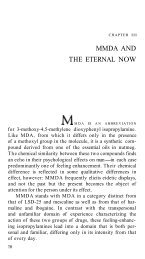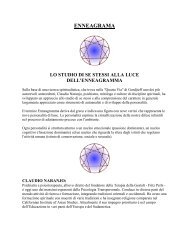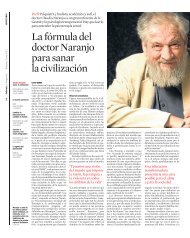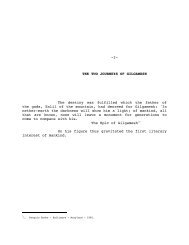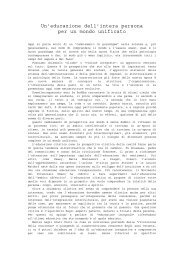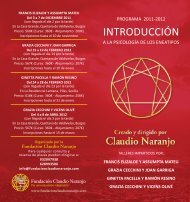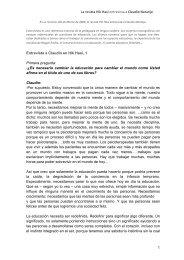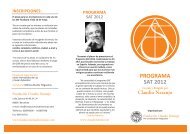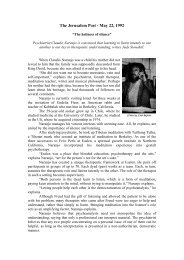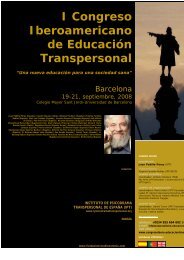Present – Centeredness in Gestalt Therapy Claudio Naranjo
Present – Centeredness in Gestalt Therapy Claudio Naranjo
Present – Centeredness in Gestalt Therapy Claudio Naranjo
You also want an ePaper? Increase the reach of your titles
YUMPU automatically turns print PDFs into web optimized ePapers that Google loves.
In the follow<strong>in</strong>g pages I will consider <strong>in</strong> some detail one of the aspects of actuality, <strong>in</strong> itself one<br />
aspect of the philosophy of life of <strong>Gestalt</strong> therapy. In choos<strong>in</strong>g liv<strong>in</strong>g-<strong>in</strong>-the-moment as a theme, I am<br />
not imply<strong>in</strong>g that this is more important than the issues of consciousness or responsibility, but only<br />
limit<strong>in</strong>g the scope of this paper to the subject on which I feel most <strong>in</strong>cl<strong>in</strong>ed to write at the moment. I<br />
th<strong>in</strong>k, too, that whatever the po<strong>in</strong>t of departure, the content will be somewhat similar, for the three<br />
issues are only superficially dist<strong>in</strong>ct. On close exam<strong>in</strong>ation we may discover, for <strong>in</strong>stance, that the<br />
question of actuality is not only related to the valuation of present tense and present locus, but also<br />
to the valu<strong>in</strong>g of concrete reality, sens<strong>in</strong>g and feel<strong>in</strong>g rather than th<strong>in</strong>k<strong>in</strong>g and imag<strong>in</strong><strong>in</strong>g, to<br />
awareness, and to self-determ<strong>in</strong>ation. More specifically, I hope that the follow<strong>in</strong>g pages will show that<br />
the will<strong>in</strong>gness to live <strong>in</strong> the moment is <strong>in</strong>separable from the question of openness to experience,<br />
trust <strong>in</strong> the work<strong>in</strong>gs of reality, discrim<strong>in</strong>ation between reality and fantasy, surrender of control and<br />
acceptance of potential frustration, a hedonistic outlook, and awareness of potential death. All these<br />
issues are facets of a s<strong>in</strong>gle experience of be<strong>in</strong>g-<strong>in</strong>-the-world, and look<strong>in</strong>g at such an experience from<br />
the perspective of presentcenteredness rather than other conceptual vantage po<strong>in</strong>ts amounts to an<br />
arbitrary choice....<br />
PRESENT-CENTEREDNESS AS TECHNIQUE<br />
There are at least two ways <strong>in</strong> which present-centeredness is reflected <strong>in</strong> the technical repertoire of<br />
<strong>Gestalt</strong> therapy. One is the outspoken request to the patient to attend to and express what enters<br />
his present field of awareness. This will most often be coupled with the <strong>in</strong>struction to suspend<br />
reason<strong>in</strong>g <strong>in</strong> favor of pure self-observation. The second is the presentification of the past or future<br />
(or fantasy <strong>in</strong> general). This may take the form of an <strong>in</strong>ward attempt to identify with or relive past<br />
events or, most often, a reenact<strong>in</strong>g of the scenes with gestural and postural participation as well as<br />
verbal exchanges, as <strong>in</strong> psychodrama.<br />
Both techniques have antecedents <strong>in</strong> spiritual discipl<strong>in</strong>es older than psychotherapy, and it could not<br />
be otherwise, given their importance. <strong>Present</strong>ification is found <strong>in</strong> the history of drama, magic, and<br />
ritual, and <strong>in</strong> the enact<strong>in</strong>g of dreams among some primitive people. Dwell<strong>in</strong>g <strong>in</strong> the present is the<br />
cornerstone of some forms of meditation. Yet both presentification and dwell<strong>in</strong>g <strong>in</strong> the present f<strong>in</strong>d<br />
<strong>in</strong> <strong>Gestalt</strong> therapy a dist<strong>in</strong>ctive embodiment and form of utilization that deserve discussion at length.<br />
In the follow<strong>in</strong>g pages I will concentrate on the approach called the exercise of the cont<strong>in</strong>uum of<br />
awareness. S<strong>in</strong>ce it is very much like a meditation translated <strong>in</strong>to words, and its role <strong>in</strong> <strong>Gestalt</strong><br />
therapy is comparable to that of free-association <strong>in</strong> psychoanalysis, I will deal with it mostly <strong>in</strong><br />
comparative terms.<br />
<strong>Gestalt</strong> <strong>Therapy</strong> and Meditation<br />
The practice of attention to present experience has had a place <strong>in</strong> several traditions of spiritual<br />
discipl<strong>in</strong>e. In Buddhism it is a corollary of "right- m<strong>in</strong>dfulness," one of the factors <strong>in</strong> the "Noble<br />
Eightfold Path." An aspect of right-m<strong>in</strong>dfulness is the practice of "bare attention":<br />
Bare Attention is concerned only with the present. It teaches what so many have forgotten: to live with<br />
full awareness <strong>in</strong> the Here and Now. It teaches us to face the present without try<strong>in</strong>g to escape <strong>in</strong>to<br />
thoughts about the past or the future. Past and future are, for average consciousness, not objects of<br />
observation, but of reflection. And, <strong>in</strong> ord<strong>in</strong>ary life, the past and the future are taken but rarely as



